3D Printing Report: Additive Manufacturing, Applications, and Forecast
VerifiedAdded on 2020/05/04
|8
|1660
|172
Report
AI Summary
This report provides a comprehensive overview of 3D printing, also known as additive manufacturing. It explores the core concepts, including how 3D printing works by layering materials to create three-dimensional objects. The report examines the suitability of 3D printing for different production volumes, highlighting its advantages in low-volume scenarios. It also delves into valuable applications of 3D printing across various sectors, with a focus on healthcare and design. Furthermore, the report analyzes forecasts from research and investment firms regarding the future of 3D printing technologies, materials, and costs. Finally, it discusses how 3D printing is making some aspects of traditional manufacturing obsolete, particularly in the production of spare parts. The report concludes by emphasizing the importance for companies to embrace this technology to remain competitive in the evolving technological market.

1
Running Head: 3-D PRINTING
3D PRINITING
Student’s Name:
Institution Affiliation
Running Head: 3-D PRINTING
3D PRINITING
Student’s Name:
Institution Affiliation
Paraphrase This Document
Need a fresh take? Get an instant paraphrase of this document with our AI Paraphraser
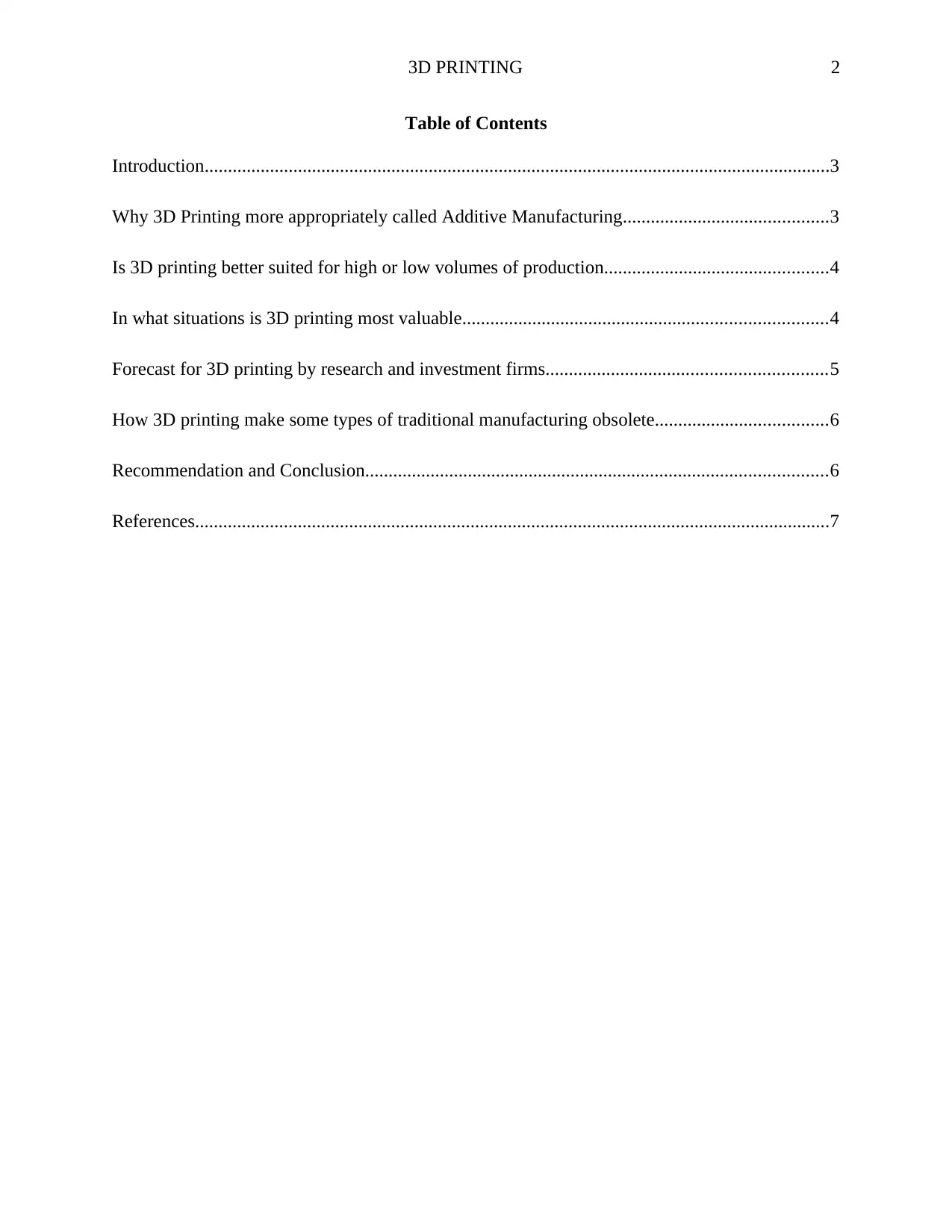
3D PRINTING 2
Table of Contents
Introduction......................................................................................................................................3
Why 3D Printing more appropriately called Additive Manufacturing............................................3
Is 3D printing better suited for high or low volumes of production................................................4
In what situations is 3D printing most valuable..............................................................................4
Forecast for 3D printing by research and investment firms............................................................5
How 3D printing make some types of traditional manufacturing obsolete.....................................6
Recommendation and Conclusion...................................................................................................6
References........................................................................................................................................7
Table of Contents
Introduction......................................................................................................................................3
Why 3D Printing more appropriately called Additive Manufacturing............................................3
Is 3D printing better suited for high or low volumes of production................................................4
In what situations is 3D printing most valuable..............................................................................4
Forecast for 3D printing by research and investment firms............................................................5
How 3D printing make some types of traditional manufacturing obsolete.....................................6
Recommendation and Conclusion...................................................................................................6
References........................................................................................................................................7
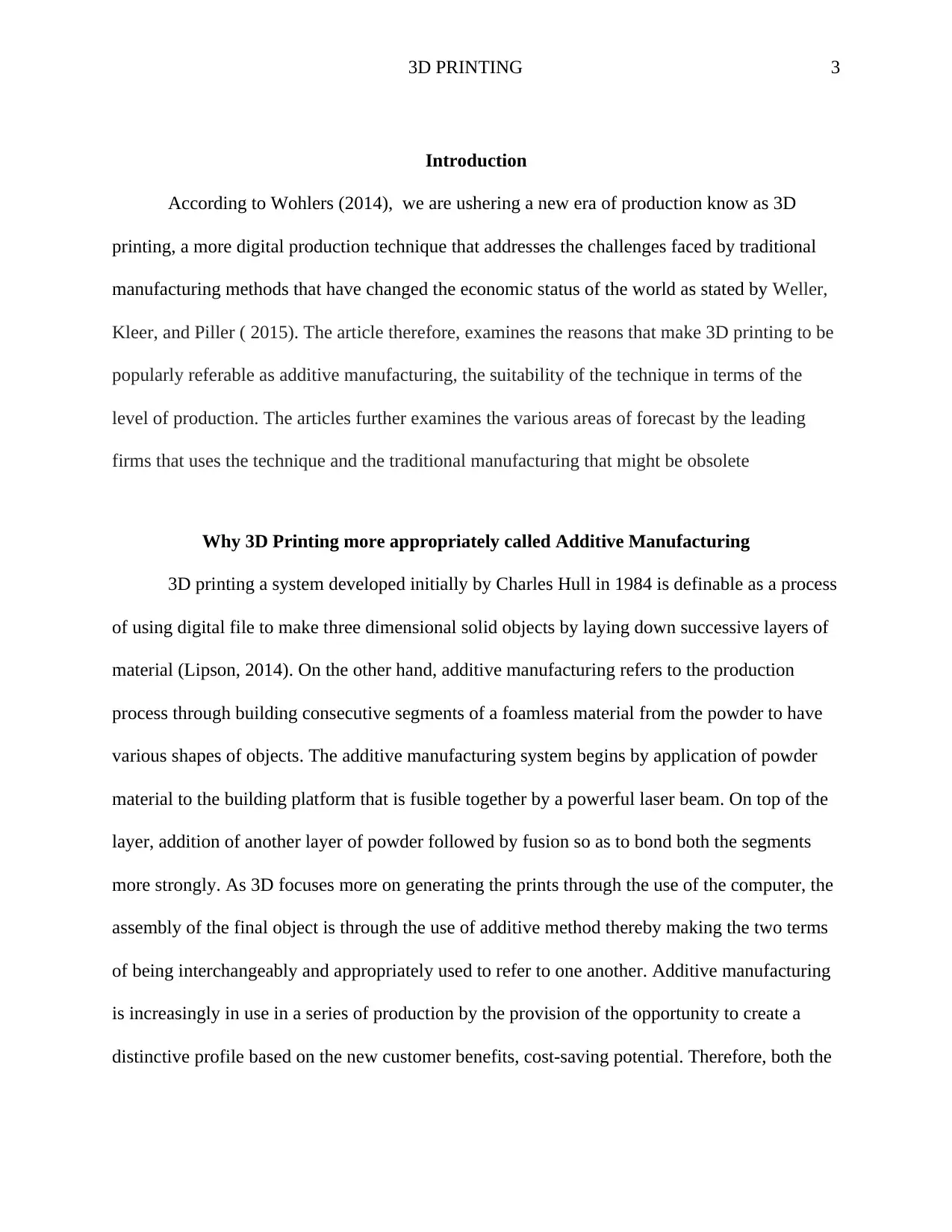
3D PRINTING 3
Introduction
According to Wohlers (2014), we are ushering a new era of production know as 3D
printing, a more digital production technique that addresses the challenges faced by traditional
manufacturing methods that have changed the economic status of the world as stated by Weller,
Kleer, and Piller ( 2015). The article therefore, examines the reasons that make 3D printing to be
popularly referable as additive manufacturing, the suitability of the technique in terms of the
level of production. The articles further examines the various areas of forecast by the leading
firms that uses the technique and the traditional manufacturing that might be obsolete
Why 3D Printing more appropriately called Additive Manufacturing
3D printing a system developed initially by Charles Hull in 1984 is definable as a process
of using digital file to make three dimensional solid objects by laying down successive layers of
material (Lipson, 2014). On the other hand, additive manufacturing refers to the production
process through building consecutive segments of a foamless material from the powder to have
various shapes of objects. The additive manufacturing system begins by application of powder
material to the building platform that is fusible together by a powerful laser beam. On top of the
layer, addition of another layer of powder followed by fusion so as to bond both the segments
more strongly. As 3D focuses more on generating the prints through the use of the computer, the
assembly of the final object is through the use of additive method thereby making the two terms
of being interchangeably and appropriately used to refer to one another. Additive manufacturing
is increasingly in use in a series of production by the provision of the opportunity to create a
distinctive profile based on the new customer benefits, cost-saving potential. Therefore, both the
Introduction
According to Wohlers (2014), we are ushering a new era of production know as 3D
printing, a more digital production technique that addresses the challenges faced by traditional
manufacturing methods that have changed the economic status of the world as stated by Weller,
Kleer, and Piller ( 2015). The article therefore, examines the reasons that make 3D printing to be
popularly referable as additive manufacturing, the suitability of the technique in terms of the
level of production. The articles further examines the various areas of forecast by the leading
firms that uses the technique and the traditional manufacturing that might be obsolete
Why 3D Printing more appropriately called Additive Manufacturing
3D printing a system developed initially by Charles Hull in 1984 is definable as a process
of using digital file to make three dimensional solid objects by laying down successive layers of
material (Lipson, 2014). On the other hand, additive manufacturing refers to the production
process through building consecutive segments of a foamless material from the powder to have
various shapes of objects. The additive manufacturing system begins by application of powder
material to the building platform that is fusible together by a powerful laser beam. On top of the
layer, addition of another layer of powder followed by fusion so as to bond both the segments
more strongly. As 3D focuses more on generating the prints through the use of the computer, the
assembly of the final object is through the use of additive method thereby making the two terms
of being interchangeably and appropriately used to refer to one another. Additive manufacturing
is increasingly in use in a series of production by the provision of the opportunity to create a
distinctive profile based on the new customer benefits, cost-saving potential. Therefore, both the
⊘ This is a preview!⊘
Do you want full access?
Subscribe today to unlock all pages.

Trusted by 1+ million students worldwide
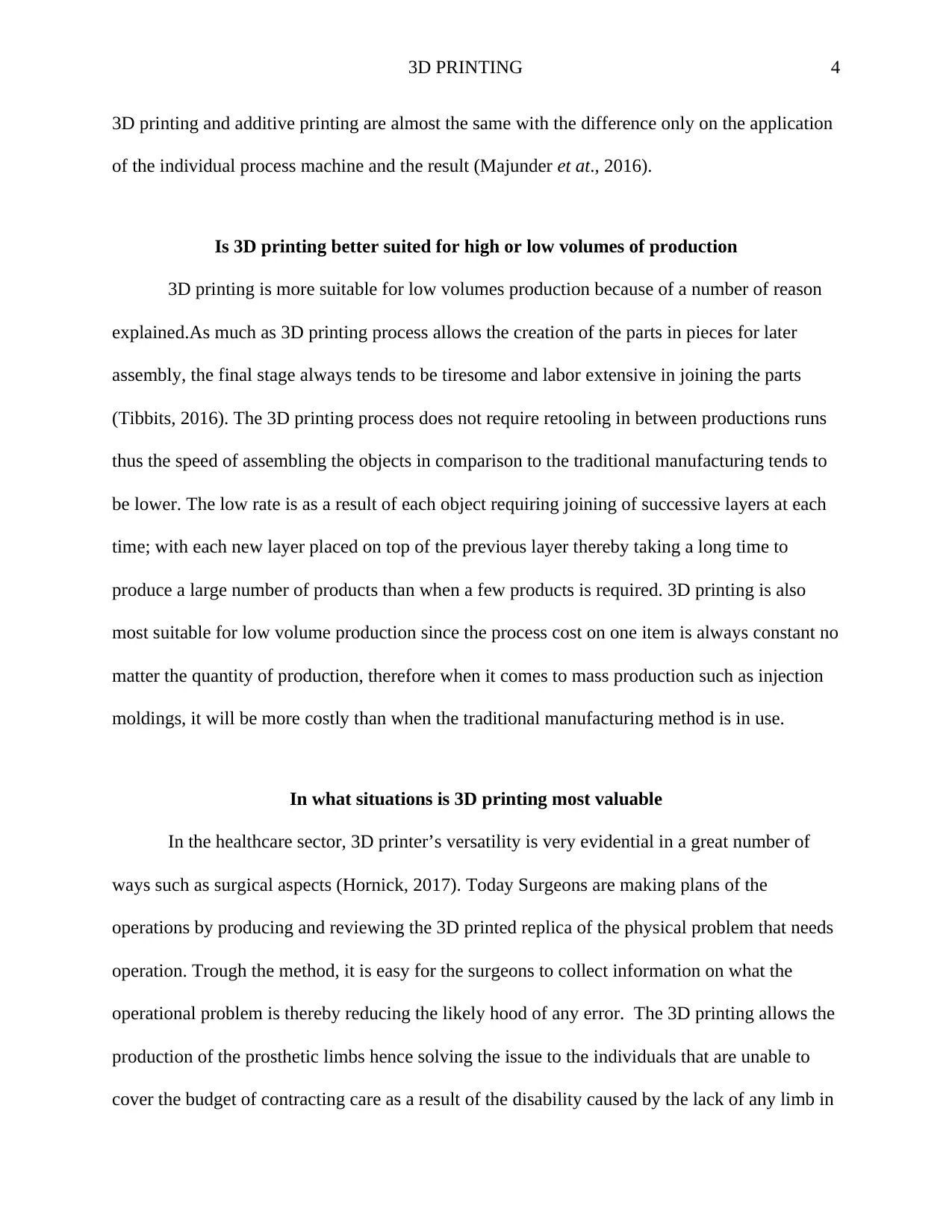
3D PRINTING 4
3D printing and additive printing are almost the same with the difference only on the application
of the individual process machine and the result (Majunder et at., 2016).
Is 3D printing better suited for high or low volumes of production
3D printing is more suitable for low volumes production because of a number of reason
explained.As much as 3D printing process allows the creation of the parts in pieces for later
assembly, the final stage always tends to be tiresome and labor extensive in joining the parts
(Tibbits, 2016). The 3D printing process does not require retooling in between productions runs
thus the speed of assembling the objects in comparison to the traditional manufacturing tends to
be lower. The low rate is as a result of each object requiring joining of successive layers at each
time; with each new layer placed on top of the previous layer thereby taking a long time to
produce a large number of products than when a few products is required. 3D printing is also
most suitable for low volume production since the process cost on one item is always constant no
matter the quantity of production, therefore when it comes to mass production such as injection
moldings, it will be more costly than when the traditional manufacturing method is in use.
In what situations is 3D printing most valuable
In the healthcare sector, 3D printer’s versatility is very evidential in a great number of
ways such as surgical aspects (Hornick, 2017). Today Surgeons are making plans of the
operations by producing and reviewing the 3D printed replica of the physical problem that needs
operation. Trough the method, it is easy for the surgeons to collect information on what the
operational problem is thereby reducing the likely hood of any error. The 3D printing allows the
production of the prosthetic limbs hence solving the issue to the individuals that are unable to
cover the budget of contracting care as a result of the disability caused by the lack of any limb in
3D printing and additive printing are almost the same with the difference only on the application
of the individual process machine and the result (Majunder et at., 2016).
Is 3D printing better suited for high or low volumes of production
3D printing is more suitable for low volumes production because of a number of reason
explained.As much as 3D printing process allows the creation of the parts in pieces for later
assembly, the final stage always tends to be tiresome and labor extensive in joining the parts
(Tibbits, 2016). The 3D printing process does not require retooling in between productions runs
thus the speed of assembling the objects in comparison to the traditional manufacturing tends to
be lower. The low rate is as a result of each object requiring joining of successive layers at each
time; with each new layer placed on top of the previous layer thereby taking a long time to
produce a large number of products than when a few products is required. 3D printing is also
most suitable for low volume production since the process cost on one item is always constant no
matter the quantity of production, therefore when it comes to mass production such as injection
moldings, it will be more costly than when the traditional manufacturing method is in use.
In what situations is 3D printing most valuable
In the healthcare sector, 3D printer’s versatility is very evidential in a great number of
ways such as surgical aspects (Hornick, 2017). Today Surgeons are making plans of the
operations by producing and reviewing the 3D printed replica of the physical problem that needs
operation. Trough the method, it is easy for the surgeons to collect information on what the
operational problem is thereby reducing the likely hood of any error. The 3D printing allows the
production of the prosthetic limbs hence solving the issue to the individuals that are unable to
cover the budget of contracting care as a result of the disability caused by the lack of any limb in
Paraphrase This Document
Need a fresh take? Get an instant paraphrase of this document with our AI Paraphraser
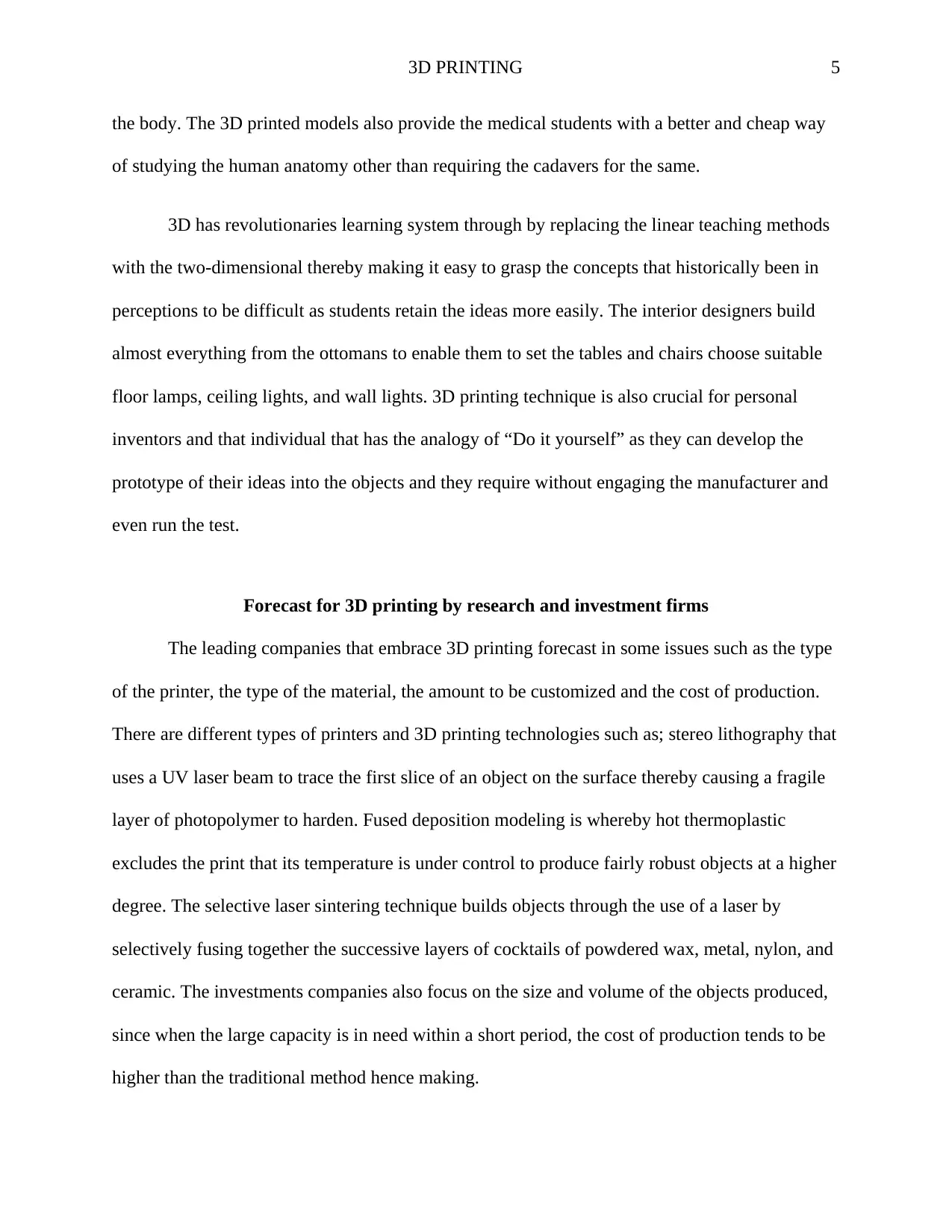
3D PRINTING 5
the body. The 3D printed models also provide the medical students with a better and cheap way
of studying the human anatomy other than requiring the cadavers for the same.
3D has revolutionaries learning system through by replacing the linear teaching methods
with the two-dimensional thereby making it easy to grasp the concepts that historically been in
perceptions to be difficult as students retain the ideas more easily. The interior designers build
almost everything from the ottomans to enable them to set the tables and chairs choose suitable
floor lamps, ceiling lights, and wall lights. 3D printing technique is also crucial for personal
inventors and that individual that has the analogy of “Do it yourself” as they can develop the
prototype of their ideas into the objects and they require without engaging the manufacturer and
even run the test.
Forecast for 3D printing by research and investment firms
The leading companies that embrace 3D printing forecast in some issues such as the type
of the printer, the type of the material, the amount to be customized and the cost of production.
There are different types of printers and 3D printing technologies such as; stereo lithography that
uses a UV laser beam to trace the first slice of an object on the surface thereby causing a fragile
layer of photopolymer to harden. Fused deposition modeling is whereby hot thermoplastic
excludes the print that its temperature is under control to produce fairly robust objects at a higher
degree. The selective laser sintering technique builds objects through the use of a laser by
selectively fusing together the successive layers of cocktails of powdered wax, metal, nylon, and
ceramic. The investments companies also focus on the size and volume of the objects produced,
since when the large capacity is in need within a short period, the cost of production tends to be
higher than the traditional method hence making.
the body. The 3D printed models also provide the medical students with a better and cheap way
of studying the human anatomy other than requiring the cadavers for the same.
3D has revolutionaries learning system through by replacing the linear teaching methods
with the two-dimensional thereby making it easy to grasp the concepts that historically been in
perceptions to be difficult as students retain the ideas more easily. The interior designers build
almost everything from the ottomans to enable them to set the tables and chairs choose suitable
floor lamps, ceiling lights, and wall lights. 3D printing technique is also crucial for personal
inventors and that individual that has the analogy of “Do it yourself” as they can develop the
prototype of their ideas into the objects and they require without engaging the manufacturer and
even run the test.
Forecast for 3D printing by research and investment firms
The leading companies that embrace 3D printing forecast in some issues such as the type
of the printer, the type of the material, the amount to be customized and the cost of production.
There are different types of printers and 3D printing technologies such as; stereo lithography that
uses a UV laser beam to trace the first slice of an object on the surface thereby causing a fragile
layer of photopolymer to harden. Fused deposition modeling is whereby hot thermoplastic
excludes the print that its temperature is under control to produce fairly robust objects at a higher
degree. The selective laser sintering technique builds objects through the use of a laser by
selectively fusing together the successive layers of cocktails of powdered wax, metal, nylon, and
ceramic. The investments companies also focus on the size and volume of the objects produced,
since when the large capacity is in need within a short period, the cost of production tends to be
higher than the traditional method hence making.
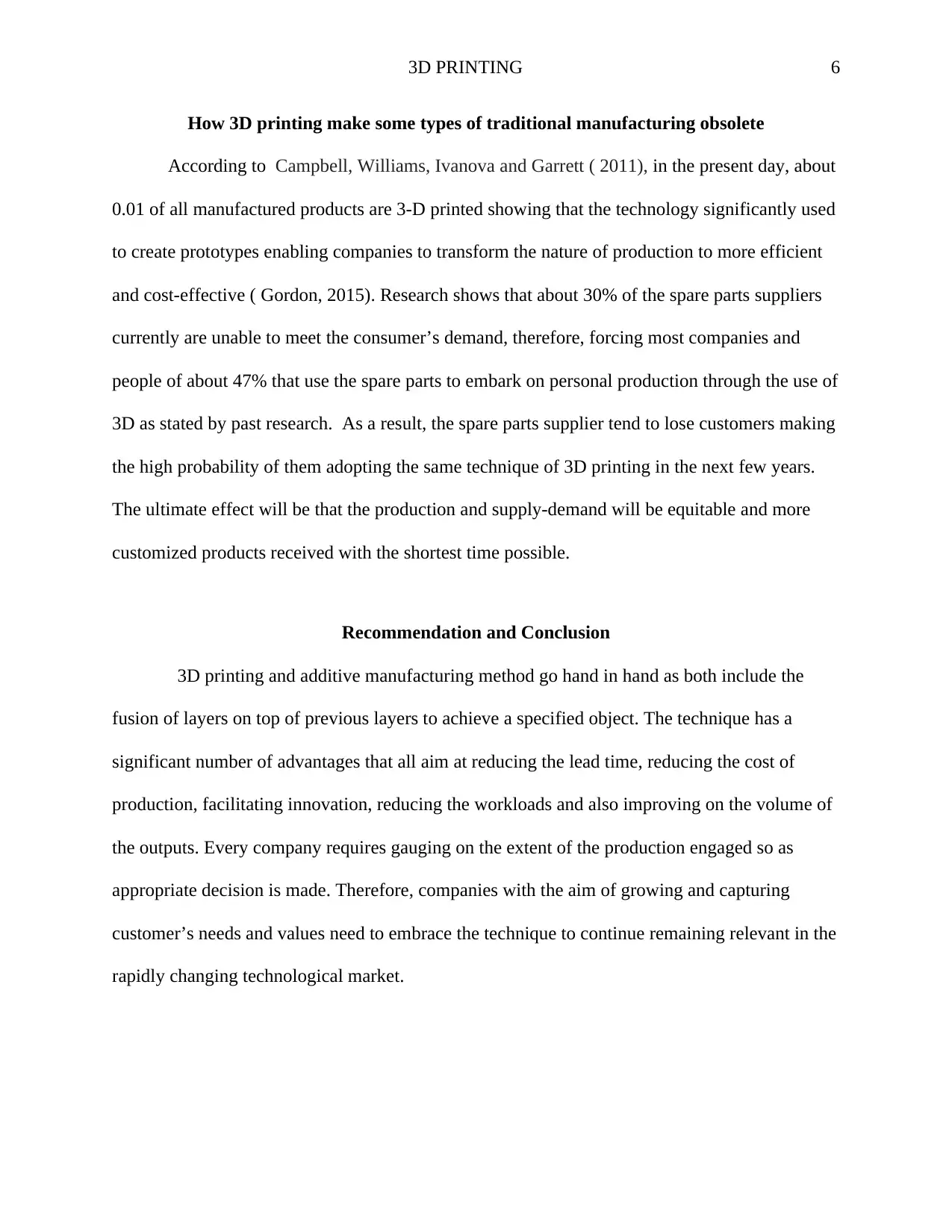
3D PRINTING 6
How 3D printing make some types of traditional manufacturing obsolete
According to Campbell, Williams, Ivanova and Garrett ( 2011), in the present day, about
0.01 of all manufactured products are 3-D printed showing that the technology significantly used
to create prototypes enabling companies to transform the nature of production to more efficient
and cost-effective ( Gordon, 2015). Research shows that about 30% of the spare parts suppliers
currently are unable to meet the consumer’s demand, therefore, forcing most companies and
people of about 47% that use the spare parts to embark on personal production through the use of
3D as stated by past research. As a result, the spare parts supplier tend to lose customers making
the high probability of them adopting the same technique of 3D printing in the next few years.
The ultimate effect will be that the production and supply-demand will be equitable and more
customized products received with the shortest time possible.
Recommendation and Conclusion
3D printing and additive manufacturing method go hand in hand as both include the
fusion of layers on top of previous layers to achieve a specified object. The technique has a
significant number of advantages that all aim at reducing the lead time, reducing the cost of
production, facilitating innovation, reducing the workloads and also improving on the volume of
the outputs. Every company requires gauging on the extent of the production engaged so as
appropriate decision is made. Therefore, companies with the aim of growing and capturing
customer’s needs and values need to embrace the technique to continue remaining relevant in the
rapidly changing technological market.
How 3D printing make some types of traditional manufacturing obsolete
According to Campbell, Williams, Ivanova and Garrett ( 2011), in the present day, about
0.01 of all manufactured products are 3-D printed showing that the technology significantly used
to create prototypes enabling companies to transform the nature of production to more efficient
and cost-effective ( Gordon, 2015). Research shows that about 30% of the spare parts suppliers
currently are unable to meet the consumer’s demand, therefore, forcing most companies and
people of about 47% that use the spare parts to embark on personal production through the use of
3D as stated by past research. As a result, the spare parts supplier tend to lose customers making
the high probability of them adopting the same technique of 3D printing in the next few years.
The ultimate effect will be that the production and supply-demand will be equitable and more
customized products received with the shortest time possible.
Recommendation and Conclusion
3D printing and additive manufacturing method go hand in hand as both include the
fusion of layers on top of previous layers to achieve a specified object. The technique has a
significant number of advantages that all aim at reducing the lead time, reducing the cost of
production, facilitating innovation, reducing the workloads and also improving on the volume of
the outputs. Every company requires gauging on the extent of the production engaged so as
appropriate decision is made. Therefore, companies with the aim of growing and capturing
customer’s needs and values need to embrace the technique to continue remaining relevant in the
rapidly changing technological market.
⊘ This is a preview!⊘
Do you want full access?
Subscribe today to unlock all pages.

Trusted by 1+ million students worldwide
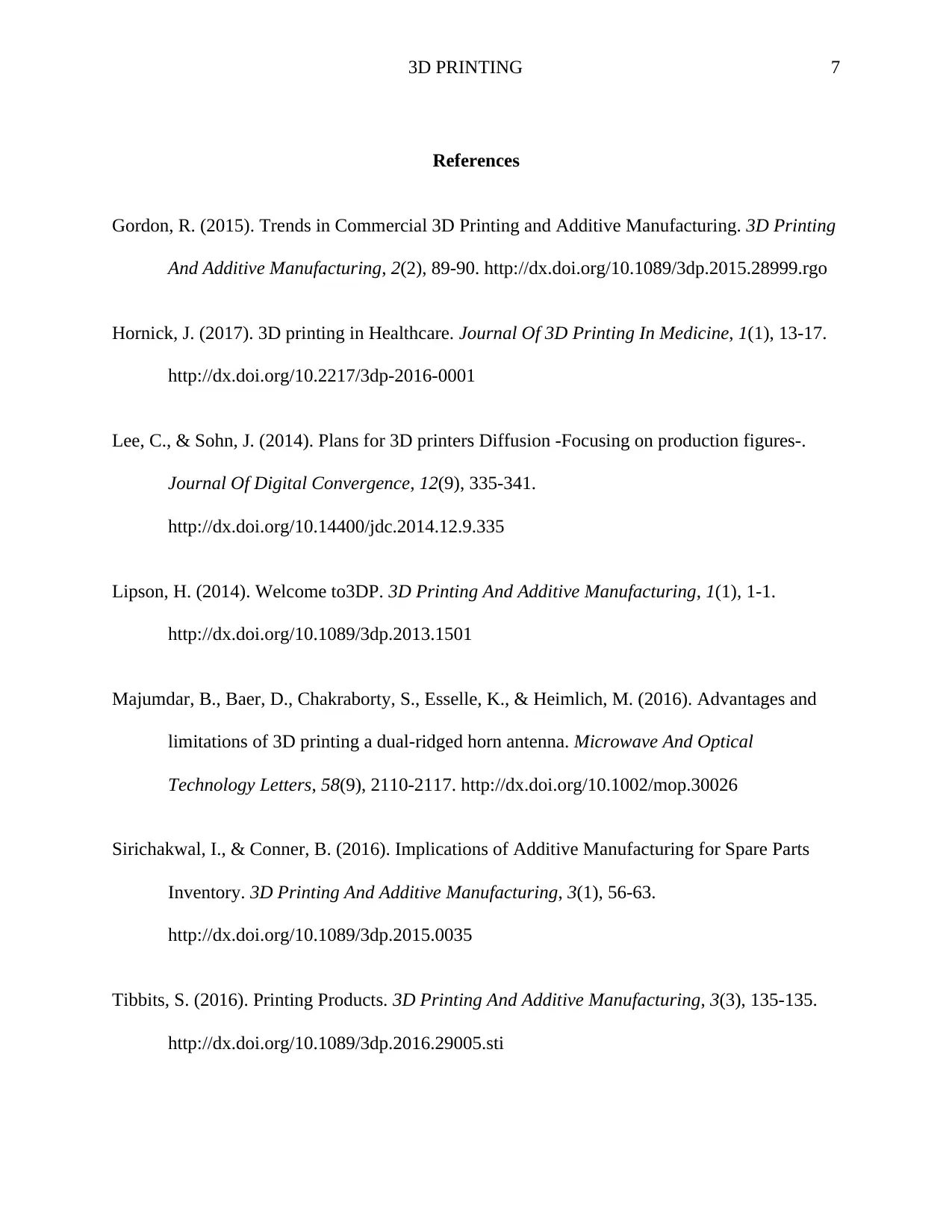
3D PRINTING 7
References
Gordon, R. (2015). Trends in Commercial 3D Printing and Additive Manufacturing. 3D Printing
And Additive Manufacturing, 2(2), 89-90. http://dx.doi.org/10.1089/3dp.2015.28999.rgo
Hornick, J. (2017). 3D printing in Healthcare. Journal Of 3D Printing In Medicine, 1(1), 13-17.
http://dx.doi.org/10.2217/3dp-2016-0001
Lee, C., & Sohn, J. (2014). Plans for 3D printers Diffusion -Focusing on production figures-.
Journal Of Digital Convergence, 12(9), 335-341.
http://dx.doi.org/10.14400/jdc.2014.12.9.335
Lipson, H. (2014). Welcome to3DP. 3D Printing And Additive Manufacturing, 1(1), 1-1.
http://dx.doi.org/10.1089/3dp.2013.1501
Majumdar, B., Baer, D., Chakraborty, S., Esselle, K., & Heimlich, M. (2016). Advantages and
limitations of 3D printing a dual-ridged horn antenna. Microwave And Optical
Technology Letters, 58(9), 2110-2117. http://dx.doi.org/10.1002/mop.30026
Sirichakwal, I., & Conner, B. (2016). Implications of Additive Manufacturing for Spare Parts
Inventory. 3D Printing And Additive Manufacturing, 3(1), 56-63.
http://dx.doi.org/10.1089/3dp.2015.0035
Tibbits, S. (2016). Printing Products. 3D Printing And Additive Manufacturing, 3(3), 135-135.
http://dx.doi.org/10.1089/3dp.2016.29005.sti
References
Gordon, R. (2015). Trends in Commercial 3D Printing and Additive Manufacturing. 3D Printing
And Additive Manufacturing, 2(2), 89-90. http://dx.doi.org/10.1089/3dp.2015.28999.rgo
Hornick, J. (2017). 3D printing in Healthcare. Journal Of 3D Printing In Medicine, 1(1), 13-17.
http://dx.doi.org/10.2217/3dp-2016-0001
Lee, C., & Sohn, J. (2014). Plans for 3D printers Diffusion -Focusing on production figures-.
Journal Of Digital Convergence, 12(9), 335-341.
http://dx.doi.org/10.14400/jdc.2014.12.9.335
Lipson, H. (2014). Welcome to3DP. 3D Printing And Additive Manufacturing, 1(1), 1-1.
http://dx.doi.org/10.1089/3dp.2013.1501
Majumdar, B., Baer, D., Chakraborty, S., Esselle, K., & Heimlich, M. (2016). Advantages and
limitations of 3D printing a dual-ridged horn antenna. Microwave And Optical
Technology Letters, 58(9), 2110-2117. http://dx.doi.org/10.1002/mop.30026
Sirichakwal, I., & Conner, B. (2016). Implications of Additive Manufacturing for Spare Parts
Inventory. 3D Printing And Additive Manufacturing, 3(1), 56-63.
http://dx.doi.org/10.1089/3dp.2015.0035
Tibbits, S. (2016). Printing Products. 3D Printing And Additive Manufacturing, 3(3), 135-135.
http://dx.doi.org/10.1089/3dp.2016.29005.sti
Paraphrase This Document
Need a fresh take? Get an instant paraphrase of this document with our AI Paraphraser
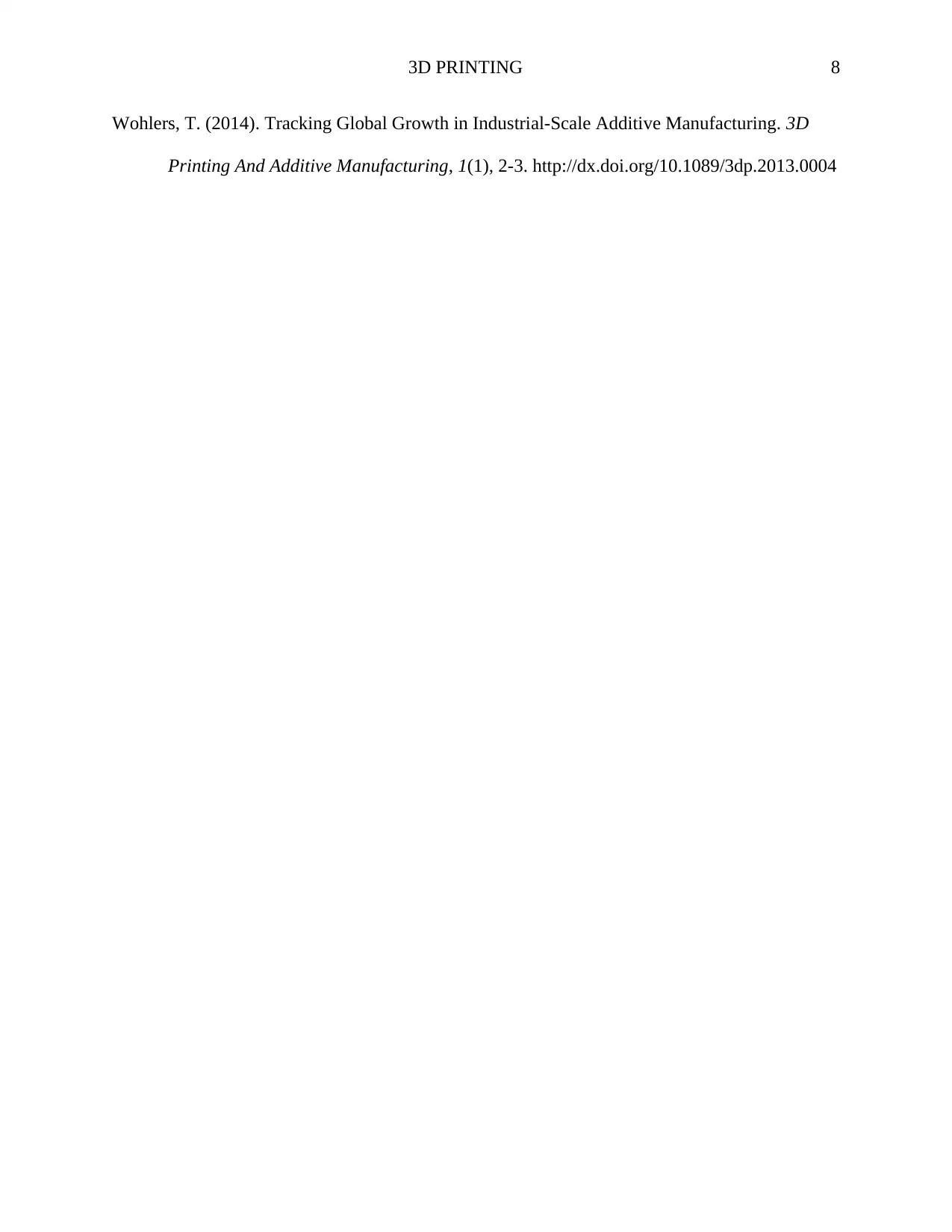
3D PRINTING 8
Wohlers, T. (2014). Tracking Global Growth in Industrial-Scale Additive Manufacturing. 3D
Printing And Additive Manufacturing, 1(1), 2-3. http://dx.doi.org/10.1089/3dp.2013.0004
Wohlers, T. (2014). Tracking Global Growth in Industrial-Scale Additive Manufacturing. 3D
Printing And Additive Manufacturing, 1(1), 2-3. http://dx.doi.org/10.1089/3dp.2013.0004
1 out of 8
Related Documents
Your All-in-One AI-Powered Toolkit for Academic Success.
+13062052269
info@desklib.com
Available 24*7 on WhatsApp / Email
![[object Object]](/_next/static/media/star-bottom.7253800d.svg)
Unlock your academic potential
Copyright © 2020–2025 A2Z Services. All Rights Reserved. Developed and managed by ZUCOL.





